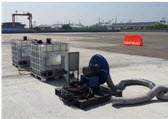28 February 2018
A significant milestone (click here) has been reached in replacing methyl bromide as the standard fumigant for export logs and timber.
The Environmental Protection Authority has just released application details for approval of ethanedinitrile (EDN) as a fumigant for log and timber exports.
The forest industry anticipates EDN could replace methyl bromide fumigation which is used on log exports to China and India. Methyl bromide is an ozone depleting chemical. Regulations due to come into effect in 2020 will make it considerably more difficult and expensive to use.
The Chair of Stakeholders in Methyl Bromide Reduction (STIMBR) Don Hammond, says approval by the EPA is the critical first step into its use in New Zealand to ensure log exports are free of pests the importing countries don’t want.
"Over the past seven years STIMBR and our co-funding partners, including the New Zealand government, have invested more than $22 million in research on alternatives to methyl bromide, as well as ways to reduce the amounts that need to be used, along with recapture and destruction technologies," Don Hammond says.
He says an extensive review of scientific literature commissioned by STIMBR in 2014 found only one promising fumigant alternative to methyl bromide.
"Plant and Food Research confirmed EDN is an effective phytosanitary treatment for insects which might be found on our logs."
"There are clear advantages of EDN over methyl bromide. EDN has no effect on the ozone layer. It is not a greenhouse gas. It does not bioaccumulate because it breaks down rapidly in the environment without leaving harmful residues in the soil or in water," Don Hammond says.
EDN is currently manufactured by Draslovka a family-owned company based in the Czech Republic. Over the past three years Don Hammond says Draslovka has made significant investment to develop EDN into a commercially viable and environmentally sustainable alternative to methyl bromide for use globally as a soil and commodity treatment.
This is an easy way to lower a country's greenhouse gas inventory.
An ozone-friendly alternative to methyl bromide (click here)
Based on ethanedinitrile, EDN® FUMIGAS is an ozone-friendly alternative to methyl bromide. EDN FUMIGAS limits the impact of pests and disease on timber and in agriculture. It can be used to sterilise soil and control insects, diseases, nematodes, weeds and other parasites before planting fruit and vegetables. It can also be used to fumigate harvested timber and logs. High penetration characteristics make it ideal for eliminating wood boring beetles in timber for instance....
There is the method of Methyl bromide capture, but, why risk it?
Laem Chabang (click here) is one of the Top 20 largest container ports in the world, and has made Methyl Bromide fumigant recapture a requirement for fumigation at
 the port. Cranes and Equipment Co,Ltd ( CEA) is coordinating the logistics for important components for Western Australia’s largest LNG project, coming from Thailand.
the port. Cranes and Equipment Co,Ltd ( CEA) is coordinating the logistics for important components for Western Australia’s largest LNG project, coming from Thailand.
Nordiko is proud to have been the supplier CEA selected to meet this standard, and commissioned a new IBC fumigant recapture system in March 2013. After performing its biosecurity function, this pesticide is recaptured on activated carbon filters, preventing the emission of this Ozone Depleting Substance to atmosphere.
The LNG Project meets the most stringent quarantine standards, in order to protect the unique ecology of Barrow Island. In this case, Methyl Bromide fumigation was an Australian Government requirement for project cargo being shipped from Laem Chabang to Western Australia.
Once again the Project has set new environmental and safety standards in its operations, helping to protect the Ozone Layer by preventing emissions of this toxic Ozone Depleter.

